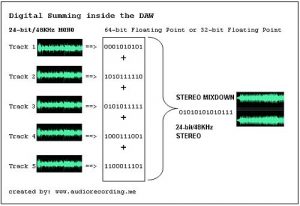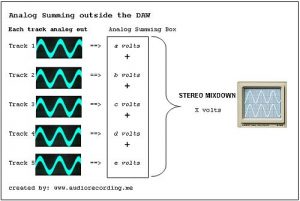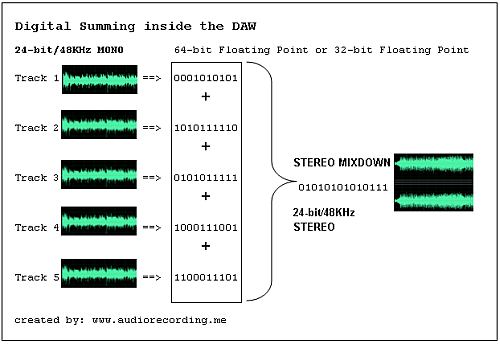There has been a lot of debate whether analog summing mixes sound better than the digital summing. This tutorial would serve as an introductory tutorial for beginners in knowing what an analog summing mixer is.
This will not prove whether analog summing mixes sound better than digital or recommend that you switch to analog summing for all of your mixes.
How does it differ from Digital Summing?
Let’s start with a more familiar digital summing. This is done inside your computer and using your DAW software such as Reaper, Protools, Cubase, etc.
In digital summing, binary bits (0’s and 1’s) also known as digital data of every track in your mix are added to produce a stereo “mixdown”. These processes are done “mathematically” inside your DAW that employs complex binary arithmetic or floating point calculation to carry out the operation.

Older DAW uses 32-bit floating point while modern DAW are adopting to 64-bit floating point calculation that improves the “accuracy” of the calculation. The computation that is going on inside your DAW during the stereo mix down process is a complicated one as it also involves a lot plug-in calculations such as reverb, EQ, compression, etc.
In this article on advantages of 64-bit DAW over 32-bit float digital audio workstation, it reveals that even a 64-bit DAW involves rounding off and estimation of calculation results. These errors however are extremely small compared to using a 32-bit bit floating point calculation.
Based on the above diagram, the factors that can affect the digital summing quality are as follows:
1.) Bit-depth and sample rate – the higher the values, the more accurate would be the digital waveform representation of analog signals. Read this pulse code modulation tutorial for details.
2.) The quality of your analog to digital converters – bear in mind that the source audio is analog and being converted to digital during the recording process. The quality of converters can play a great role in having a perfect/high-fidelity digital capture. Quality converters are often found in professional audio interface and not in consumer-grade soundcards.
3.) The digital resolution of your DAW (available in 64-bit floating point, 32-bit floating point, 48-bit fix point, etc).
So what’s analog summing?
In analog world, there are no 0’s and 1’s but only voltages. These are complex sinusoidal voltages that include the harmonics and other elements. Many engineers consider this to add the “warm”, “in-depth” and nice separation sound you get from analog.

In the above screenshot, the input to an analog summing device is analog voltage (also known as analog audio). If you use an oscilloscope to view these analog audio signals, it would be sinusoidal in nature and the amplitudes are now in voltages and not in dBFS (digital dB).
Each track that would be rendered for analog mix down is summed in the summing device and their voltages are added. While DAW (digital summing) relies on binary math and floating point calculation to do the mixdown, analog summing relies entirely on electronic circuits to do the job. There is no math involved.

Credits: Thermionic culture fat bustard
Inside the analog summing device, the entire signals are in analog domain. You can even visualize this if you connect the output of the analog summing mixer to an oscilloscope.
There are two kinds of analog summing devices commonly used in music production:
1.) Passive analog summing mixer
2.) Active analog summing mixer
Passive analog summing does not have any active electronic components on board. Example of these are the transistors, etc. that provide amplification and any other signal manipulation features. Most passive analog summing devices only consist of resistors. Example of this is the RMS216 Folcrom passive summing mixer.
Active analog summing device has complex circuitry that provides additional amplification, signal conditioning features like EQ, panning, etc. An analog mixing console is an example of an active analog summing device.









2 Responses
Thanks Chris..That’s a good point. I still have to test a lot. Probably I could remix some of my best songs and summed it up in analog to see what it sounds like after being mastered. I do have some clients being happy with my digital summing. But I read and noticed that big albums are done in analog so its worth a try to really confirm these sonic differences in your own work.
Analog summing box is a bit expensive process comparing to digital. I am still researching on feasible and quality gears to use in analog without breaking the wallet 🙂
Good article. i think the thing most people wonder is whether there is a sonic difference. most people have this romantic attachment to analog. and frankly it’s very hard to make comparisons. you could sum 24 tracks at unity gain in analog and a daw but someone really mixes like that. in practice there are plugins on every track and nothing is at unity. would still be interesting as a test.
I don’t believe sample rate has much to do with summing or audio quality. so long as you have good converters and sample > 44.1k.